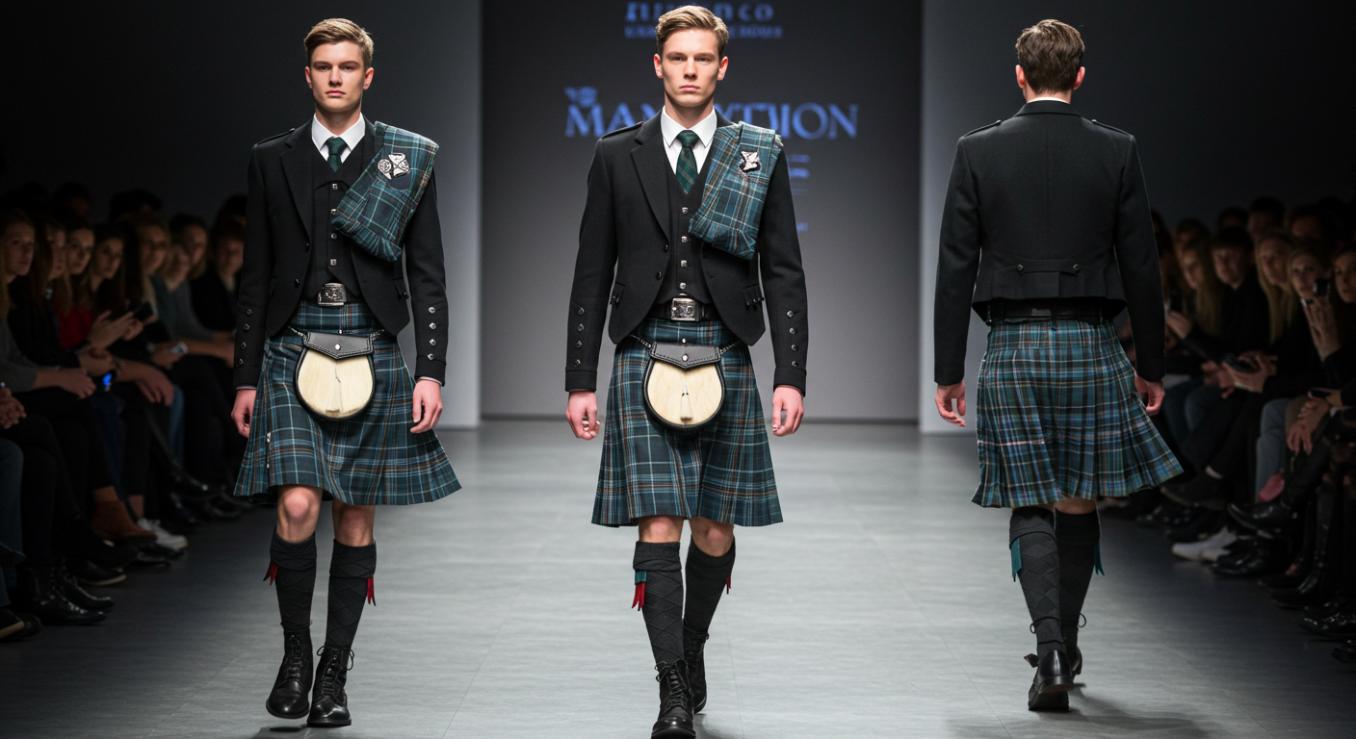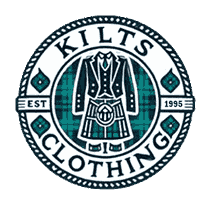From Clans to Catwalks: How Scottish Kilts Influence Modern Fashion Trends

The Scottish kilt is one of the most recognizable garments in the world. With its deep cultural significance and storied history, the Scottish kilt has evolved far beyond its original function as traditional Highland wear. While it continues to symbolize Scottish heritage, the kilt has made its way onto modern fashion runways, becoming a versatile garment embraced globally. Today, the kilt is not just about tradition; it's a statement of identity, style, and cultural pride transcending borders and periods.
This blog explores how Scottish kilts have influenced modern fashion trends, moving from their historical roots to becoming a key piece on catwalks across the globe.
1. The Historical Roots of the Kilt: A Symbol of Clan Identity
The origins of the kilt can be traced back to the Highlands of Scotland, where it was initially worn as a practical garment. The failed mór, the precursor to the modern kilt, was a large, single piece of woolen cloth wrapped around the body and belted at the waist. Men wore it for both practical and ceremonial purposes, offering warmth and flexibility in the harsh Scottish climate.
Kilts were closely tied to Scottish clan identity, with different tartan patterns representing various clans and families. The patterns, or plaids, became symbols of loyalty and pride. Wearing a specific tartan was a way to showcase one's heritage, and even today, Scottish families continue to wear their ancestral tartans as a mark of respect and connection to their roots.
2. The Kilt's Resurgence in the 19th Century: A National Symbol
In the early 19th century, the kilt experienced a revival, particularly under the influence of Queen Victoria and Prince Albert. The royal couple's affection for Scotland led to a renewed interest in Highland culture and, by extension, the kilt. Queen Victoria was famously photographed wearing a kilt-inspired outfit, and the royal endorsement helped to cement the kilt as a symbol of Scottish national pride.
The Victorian era's fascination with Scottish heritage also saw the kilt transition from a workman's garment to formal wear. By the late 1800s, kilts were worn for ceremonial occasions, including military events, weddings, and formal gatherings. This period marked the beginning of the kilt's transformation from a practical item of clothing to an essential ceremonial attire.
3. The Kilt on the Catwalk: Introduction to High Fashion
While the kilt remained rooted in tradition, it was also gaining attention from the fashion world. By the mid-20th century, designers began experimenting with the kilt, incorporating it into mainstream fashion. In particular, British designer Vivienne Westwood played a crucial role in bringing the kilt into modern fashion. Westwood, known for her work with punk fashion, incorporated tartan patterns and kilts into her collections during the 1970s and 1980s, challenging conventional fashion norms.
Westwood's iconic punk-inspired designs helped position the kilt as a rebellious statement, mixing Scottish tradition with an edgy, contemporary twist. It marked a significant departure from the kilt's traditional use, proving that this historical garment could be adapted for the modern world. Other designers, like Jean-Paul Gaultier and Thom Browne, continued this trend, incorporating kilts into their runway shows and giving the garment a more cosmopolitan and avant-garde appeal.
4. The Kilt Meets Streetwear: A Modern Take on a Classic
As fashion became more diverse and inclusive, the kilt started appearing in streetwear, especially within alternative and subcultural communities. Kilts, mainly leather and utility kilts, became popular in punk and goth subcultures. The boldness of these designs, combined with their Scottish origins, made them an attractive option for those who wanted to make a statement.
In cities like New York, London, and Tokyo, the kilt became a part of the urban fashion scene. Streetwear brands began incorporating the kilt into their collections, often blending traditional tartan with modern fabrics like denim or leather. The kilt skirt became a versatile fashion item, worn by men and women in different styles—from casual looks to more formal street styles. It became a popular choice for people looking for an eclectic, creative, and individualistic approach to fashion.
5. Celebrity Endorsement: Kilts as a Fashion Statement
The influence of celebrities cannot be underestimated when it comes to the popularization of fashion trends, and the kilt is no exception. Celebrities such as Prince William, Sean Connery, and Ewan McGregor wear kilts on public occasions, helping associate the garment with style, sophistication, and cultural pride. The sight of high-profile figures embracing the kilt on the red carpet and at public events has made the kilt an aspirational piece for many.
In the world of music, rock bands, and punk musicians have also embraced the real scottish kilt as part of their performance attire. Kilts, particularly in punk and alternative fashion, became a symbol of defiance and individuality, aligning perfectly with the rebellious attitudes of many musicians. Over time, kilts have appeared at high-profile events like the Met Gala, where designers and celebrities often experiment with their cultural significance, pushing the boundaries of fashion.
6. The Evolution of the Modern Kilt: A Fashionable Wardrobe Staple
The modern kilt is far from the simple woolen garment worn in the Scottish Highlands centuries ago. Today, kilts are available in various styles, fabrics, and cuts to suit different occasions and fashion sensibilities. Once reserved for ceremonial events, Tartan kilts are now worn as everyday attire. Many designers have adapted the kilt to meet the demands of modern fashion, offering options in fabrics such as denim, leather, and even sportswear materials.
The utility kilt is one of the most notable modern adaptations. Featuring functional pockets and a more rugged design, this variation of the kilt has gained popularity in casual settings and as workwear. It retains the traditional silhouette of the kilt. Still, it incorporates modern fashion elements, such as adjustable straps, zippers, and high-quality synthetic fabrics.
Additionally, kilts are being integrated into high-fashion collections, where they are reinvented with contemporary fabrics, cuts, and styling. Designer kilts come in various lengths, from knee-length versions to longer, more tailored looks. This adaptation allows the kilt to be worn by a broader demographic, including women, who have increasingly adopted the kilt in both formal and casual settings.
7. Kilts on the Global Runway: A Fashion Icon
Kilts have become a regular feature on the international fashion scene, with designers worldwide drawing inspiration from this iconic garment. Fashion weeks in Paris, New York, and London have all seen designers experiment with kilt-inspired collections. High fashion brands have embraced the kilt as a symbol of tradition and modernity, showcasing its versatility on the global stage.
Alexander McQueen, Thom Browne, and Dior have all featured kilts in their collections, transforming them into luxury fashion pieces. These designers reinterpreted the kilt in ways that maintain its heritage while introducing new materials and design elements. The global fashion industry's embrace of the kilt shows that traditional garments can transcend cultural boundaries and become universally recognized symbols of style.
8. The Future of the Kilt in Fashion
The kilt's influence on fashion is unlikely to fade any time soon. With its rich history, cultural significance, and modern reinventions, the kilt is poised to remain a staple of traditional and contemporary fashion. As fashion trends evolve, the kilt will likely continue to be reinterpreted in new and exciting ways. Whether as a symbol of Scottish pride, a statement of rebellion, or a fashion-forward trend, the kilt is a garment that has stood the test of time and will likely continue to shape the future of fashion.
Conclusion
The Scottish kilt has come a long way from its origins in the Highland clans. Today, it is a global symbol of heritage, pride, and style, influencing high fashion and streetwear. From traditional tartans to modern takes on the garment, the kilt has proven to adapt to changing times while remaining a powerful symbol of cultural identity. As it continues to evolve, the kilt's place in the fashion world remains secure—standing at the crossroads of tradition and modernity, as relevant today as ever.


